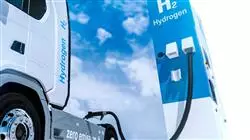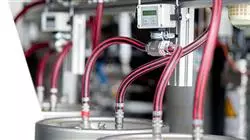University certificate
Scientific endorser

The world's largest faculty of engineering”
Introduction to the Program
This 100% online university degree will lead you to specialize in the use of hydrogen as an energy vector"

Climate change, the scarcity of fossil resources and the deterioration of the environment have led public and private institutions to promote renewable energies. Among them, hydrogen has stood out, especially in recent years. An element which is being bet on by large companies who want to maintain their share in the market through technology and innovation.
An optimal professional scenario for engineering graduates who wish to specialize in one of the sectors that has experienced the greatest boom in recent decades. However, this boost requires highly qualified personnel with technical knowledge in all processes: from production, storage, transport and distribution to end uses. In this line, TECH has designed a Professional master’s degree that provides advanced learning and goes beyond the technical professional profile, as it provides the necessary tools to lead any project using Hydrogen Technology .
A program with a theoretical-practical approach, in which this academic institution has brought together the most specialized teaching team in this area. In addition, its experience and research capacity in R&D gives an added value to this program by providing a scientific vision on the mechanisms of hydrogen generation from biomass.
In this way, students will delve into hydrogen fuel cells, refueling stations for vehicles that use this energy, the existing market itself and the elements of regulation and safety. For this purpose, it has teaching resources that will lead them to delve in a much more dynamic way in the planning and management of hydrogen projects, their feasibility and the essential technical-economic analysis.
Therefore, engineering professionals have an excellent opportunity to advance their careers through a Professional master’s degree, which they can study whenever and wherever they wish. They only need an electronic device with Internet connection to view the content hosted on the Virtual Campus. In addition, students have the freedom to distribute the teaching load according to their needs. An ideal academic option for people looking to balance their personal responsibilities with a high-level university education.
Stand out in a growing sector that demands highly specialized engineering professionals capable of leading any technological initiative that uses hydrogen"
This Professional master’s degree in Hydrogen Technology contains the most complete and up-to-date program on the market. The most important features include:
- Case studies presented by engineering experts
- The graphic, schematic and practical contents of the book provide technical and practical information on those disciplines that are essential for professional practice.
- Practical exercises where self-assessment can be used to improve learning
- Its special emphasis on innovative methodologies
- Theoretical lessons, questions to the expert, debate forums on controversial topics, and individual reflection assignments
- Content that is accessible from any fixed or portable device with an Internet connection
You are one step away from enrolling in a degree that will allow you to create and manage projects where Hydrogen Technology is used by applying the knowledge from this program"
The program’s teaching staff includes professionals from the sector who contribute their work experience to this educational program, as well as renowned specialists from leading societies and prestigious universities.
Its multimedia content, developed with the latest educational technology, will allow professionals to learn in a contextual and situated learning environment, i.e., a simulated environment that will provide immersive education programmed to learn in real situations.
The design of this program focuses on Problem-Based Learning, by means of which professionals must try to solve the different professional practice situations that are presented to them throughout the academic year. For this purpose, the student will be assisted by an innovative interactive video system created by renowned and experienced experts.
No attendance or classes with schedules. This program offers you the flexibility you are looking for to pursue a 100% online university education"

This program will allow you to delve into the generation, transportation or use of hydrogen in innovative vehicle projects"
Syllabus
The syllabus of this university degree will allow graduates to acquire specialized learning, which will lead them to make significant progress in their professional field. For this purpose, this Professional master’s degree has been created, which compiles the technical contents that facilitate the design of complete installations as well as specific equipment. It also provides a holistic view of projects, including techno-economic assessment. Likewise, they will delve into a more attractive way thanks to the innovative multimedia resources that can be accessed 24 hours a day, from any electronic device with an Internet connection.

This Professional master’s degree will allow you to know the key and crucial points for the successful realization of a real project based on Hydrogen Technology "
Module 1. Hydrogen as an Energy Vector
1.1. Hydrogen as an Energy Vector. Global Context and Necessity
1.1.1. Political and Social Context
1.1.2. Paris CO2 Emission Reduction Commitment
1.1.3. Circularity
1.2. Hydrogen Development
1.2.1. Discovery and Production of Hydrogen
1.2.2. Role of Hydrogen in Industrial Society
1.2.3. Hydrogen at Present
1.3. Hydrogen as a Chemical Element: Properties
1.3.1. Properties
1.3.2. Permeability
1.3.3. Flammability and Buoyancy Index
1.4. Hydrogen as a Fuel
1.4.1. Hydrogen Production
1.4.2. Hydrogen Storage and Distribution
1.4.3. The Use of Hydrogen as a Fuel
1.5. Hydrogen Economy
1.5.1. Decarbonization of the Economy
1.5.2. Renewable Energy Sources
1.5.3. The Road to the Hydrogen Economy
1.6. Hydrogen Value Chain
1.6.1. Production
1.6.2. Storage and Transportation
1.6.3. End-Uses
1.7. Integration with Existing Energy Infrastructures: Hydrogen as an Energy Vector
1.7.1. Regulations
1.7.2. Problems Associated with Hydrogen Embrittlement
1.7.3. Integration of Hydrogen in Energy Infrastructures. Trends and Realities
1.8. Hydrogen Technologies. Status
1.8.1. Hydrogen Technologies
1.8.2. Technologies under Development
1.8.3. Key Projects for Hydrogen Development
1.9. “Relevant” Type Projects
1.9.1. Production Projects
1.9.2. Flagship Projects in Storage and Transportation
1.9.3. Projects for the Application of Hydrogen as an Energy Vector
1.10. Hydrogen in the Global Energy Mix: Current Situation and Prospects
1.10.1. The Energy Mix. Global Context
1.10.2. Hydrogen in the Energy Mix. Current Situation
1.10.3. Development Pathways for Hydrogen. Perspectives
Module 2. Hydrogen Production and Electrolysis
2.1. Fossil Fuel Production
2.1.1. Hydrocarbon Reforming Production
2.1.2. Generation by Pyrolysis
2.1.3. Coal Gasification
2.2. Production From Biomass
2.2.1. Hydrogen Production by Biomass Gasification
2.2.2. Hydrogen Generation by Biomass Pyrolysis
2.2.3. Aqueous Reforming
2.3. Biological Production
2.3.1. Water Gas Shift Reaction (WGSR)
2.3.2. Dark Fermentation for Biohydrogen Generation
2.3.3. Photofermentation of Organic Compounds for Hydrogen Production
2.4. By-Product of Chemical Processes
2.4.1. Hydrogen as a By-Product of Petrochemical Processes
2.4.2. Hydrogen as a By-Product of Caustic Soda and Chlorine Production
2.4.3. Synthesis Gas as a By-Product Generated in Coke Ovens
2.5. Water Separation
2.5.1. Photolytic Hydrogen Formation
2.5.2. Hydrogen Generation by Photocatalysis
2.5.3. Hydrogen Production by Thermal Separation of Water
2.6. Electrolysis: The Future of Hydrogen Generation
2.6.1. Hydrogen Generation by Electrolysis
2.6.2. Oxidation-Reduction Reaction
2.6.3. Thermodynamics of Electrolysis
2.7. Electrolysis Technologies
2.7.1. Low Temperature Electrolysis: Alkaline and Anionic Technology
2.7.2. Low Temperature Electrolysis: PEM
2.7.3. High Temperature Electrolysis
2.8. Stack: The Heart of an Electrolyzer
2.8.1. Materials and Components in Low-Temperature Electrolysis
2.8.2. Materials and Components in High-Temperature Electrolysis
2.8.3. Stack Assembly in Electrolysis
2.9. Balance of Plant and System
2.9.1. Balance of Plant Components
2.9.2. Balance of Plant Design
2.9.3. Balance of Plant Optimization
2.10. Technical and Economic Characterization of Electrolyzers
2.10.1. Capital and Operating Costs
2.10.2. Technical Characterization of an Electrolyzer Operation
2.10.3. Techno-Economic Modeling
Module 3. Hydrogen Storage, Transportation and Distribution
3.1. Hydrogen Storage, Transportation, and Distribution Forms
3.1.1. Hydrogen Gas
3.1.2. Liquid Hydrogen
3.1.3. Hydrogen Storage in Solid State
3.2. Hydrogen Compression
3.2.1. Hydrogen Compression. Necessity
3.2.2. Problems Associated with the Compression of Hydrogen
3.2.3. Equipment
3.3. Gaseous State Storage
3.3.1. Problems Associated with Hydrogen Storage
3.3.2. Types of Storage Tanks
3.3.3. Storage Tank Capacities
3.4. Transportation and Distribution in Gaseous State
3.4.1. Transportation and Distribution in Gaseous State
3.4.2. Distribution by Road
3.4.3. Use of the Distribution Network
3.5. Hydrogen Storage, Transportation and Distribution as Liquid
3.5.1. Process and Conditions
3.5.2. Equipment
3.5.3. Current State
3.6. Storage, Transportation and Distribution as Methanol
3.6.1. Process and Conditions
3.6.2. Equipment
3.6.3. Current State
3.7. Storage, Transportation and Distribution as Green Ammonia
3.7.1. Process and Conditions
3.7.2. Equipment
3.7.3. Current State
3.8. Storage, Transportation and Distribution as LOHC (Liquid Organic Hydrogen)
3.8.1. Process and Conditions
3.8.2. Equipment
3.8.3. Current State
3.9. Hydrogen Export
3.9.1. Hydrogen Export. Necessity
3.9.2. Green Hydrogen Production Capabilities
3.9.3. Transportation. Technical Comparison
3.10. Comparative Techno-Economic Analysis of Alternatives for Large Scale Logistics
3.10.1. Cost of Hydrogen Export
3.10.2. Comparison between Different Means of Transportation
3.10.3. The Reality of Large-Scale Logistics
Module 4. Hydrogen End-Uses
4.1. Industrial Uses of Hydrogen
4.1.1. Hydrogen at Industries
4.1.2. Origin of Hydrogen Used in Industry. Environmental Impact
4.1.3. Industrial Uses in the Industry
4.2. Industries and Hydrogen e-Fuels Production
4.2.1. e-Fuel Versus Traditional Fuels
4.2.2. Classification of e-Fuels
4.2.3. Current Status of e-Fuels
4.3. Production of Ammonia: Haber-Bosch Process
4.3.1. Nitrogen in Figures
4.3.2. Haber-Bosch Process. Process and Equipment
4.3.3. Environmental Impact
4.4. Hydrogen in Refineries
4.4.1. Hydrogen in Refineries. Necessity
4.4.2. Hydrogen Used Today. Environmental Impact and Cost
4.4.3. Short- and Long-Term Alternatives
4.5. Hydrogen in Steel Mills
4.5.1. Hydrogen in Steel Mills. Necessity
4.5.2. Hydrogen Used Today. Environmental Impact and Cost
4.5.3. Short- and Long-Term Alternatives
4.6. Natural Gas Substitution: Blending
4.6.1. Mixing Properties
4.6.2. Problems and Required Improvements
4.6.3. Opportunities
4.7. Injection of Hydrogen into the Natural Gas Grid
4.7.1. Methodology
4.7.2. Current Capabilities
4.7.3. Problems
4.8. Hydrogen in Mobility: Fuel Cell Vehicles
4.8.1. Context and Necessity
4.8.2. Equipment and Schemes
4.8.3. Present
4.9. Cogeneration and Production of Electricity with Fuel Cells
4.9.1. Fuel Cell Production
4.9.2. Discharge to the Grid
4.9.3. Microgrids
4.10. Others Hydrogen End-Uses: Chemical, Semiconductor, Glass Industry
4.10.1. Chemical Industry
4.10.2. Semiconductor Industry
4.10.3. Glass Industry
Module 5. Hydrogen Fuel Cells
5.1. PEMFC (Proton-Exchange Membrane Fuel Cell) Fuel Cells
5.1.1. Chemistry Governing PEMFCs
5.1.2. PEMFC Operation
5.1.3. PEMFC Applications
5.2. Membrane-Electrode Assembly in PEMFCs
5.2.1. MEA Materials and Components
5.2.2. PEMFC Catalysts
5.2.3. Circularity in PEMFC
5.3. PEMFC Cell Stacks
5.3.1. Stack Architecture
5.3.2. Assembly
5.3.3. Power Generation
5.4. Balance of Plant and PEMFC Stack System
5.4.1. Balance of Plant Components
5.4.2. Balance of Plant Design
5.4.3. System Optimization
5.5. SOFC (Sodium Oxide Fuel Cells) Fuel Cells
5.5.1. Chemistry Governing SOFCs
5.5.2. SOFCs Operation
5.5.3. Applications
5.6. Other Types of Fuel Cells: Alkaline, Reversible, Direct Methanation, etc.
5.6.1. Alkaline Fuel Cells
5.6.2. Reversible Fuel Cells
5.6.3. Direct Methanation Fuel Cells
5.7. Applications of Fuel Cells I. In Mobility, Electric Power Generation, Thermal Generation
5.7.1. Fuel Cells in Mobility
5.7.2. Fuel Cells in Power Generation
5.7.3. Fuel Cells in Thermal Generation
5.8. Fuel Cell Applications II. Techno-Economic Modeling
5.8.1. Technical and Economic Characterization of the PEMFC
5.8.2. Capital and Operating Costs
5.8.3. Technical Characterization of the Operation of a PEMFC
5.8.4. Techno-Economic Modeling
5.9. Dimensioning of PEMFC for Different Applications
5.9.1. Static Modeling
5.9.2. Dynamic Modeling
5.9.3. PEMFC Integration in Vehicles
5.10. Stationary Fuel Cells Grid Integration
5.10.1. Stationary Fuel Cells in Renewable Microgrids
5.10.2. System Modeling
5.10.3. Techno-Economic Study of a Fuel Cell in Stationary Use
Module 6. Hydrogen Refueling Stations
6.1. Hydrogen Refueling Corridors and Networks
6.1.1. Hydrogen Refueling Networks. Current State
6.1.2. Global Hydrogen Vehicle Refueling Station Deployment Targets
6.1.3. Cross-Border Hydrogen Refueling Corridors
6.2. Hydrogen Plant Types, Modes of Operation and Dispensing Categories
6.2.1. Hydrogen Refueling Station Types
6.2.2. Operating Modes of the Hydrogen Refueling Stations
6.2.3. Dispensing Categories According to Standards
6.3. Design Parameters
6.3.1. Hydrogen Refueling Station. Components
6.3.2. Design Parameters according to Hydrogen Storage Type
6.3.3. Design Parameters according to the Station’s Target Use
6.4. Storage and Pressure Levels
6.4.1. Storage of Hydrogen Gas at Hydrogen Refueling Stations
6.4.2. Gas Storage Pressure Levels
6.4.3. Liquid Hydrogen Storage in Hydrogen Refueling Stations
6.5. Compression Stages
6.5.1. Hydrogen Compression. Necessity
6.5.2. Compression Technologies
6.5.3. Optimization
6.6. Dispensing and Precooling
6.6.1. Precooling according to Regulations and Vehicle Type. Necessity
6.6.2. Hydrogen Dispensing Cascade
6.6.3. Thermal Phenomena of Dispensing
6.7. Mechanical Integration
6.7.1. Refueling Stations with On-Site Hydrogen Production
6.7.2. Refueling Stations without Hydrogen Production
6.7.3. Modularization
6.8. Applicable Regulations
6.8.1. Safety Regulations
6.8.2. Hydrogen Quality Standards, Certificates
6.8.3. Civil Regulations
6.9. Preliminary Design of a Hydrogen Plant
6.9.1. Presentation of the Case Study
6.9.2. Development of the Case Study
6.9.3. Resolution
6.10. Cost Analysis
6.10.1. Capital and Operating Costs
6.10.2. Technical Characterization of a Hydrogen Refueling Station Operation
6.10.3. Techno-Economic Modeling
Module 7. Hydrogen Markets
7.1. Energy Markets
7.1.1. Integration of Hydrogen in the Gas Market
7.1.2. Interaction of Hydrogen Price with Fossil Fuels Prices
7.1.3. Interaction of the Hydrogen Price with the Electricity Market Price
7.2. Calculation of LCOHs and Sales Price Bands
7.2.1. Presentation of the Case Study
7.2.2. Development of the Case Study
7.2.3. Resolution
7.3. Global Demand Analysis
7.3.1. Current Hydrogen Demand
7.3.2. Hydrogen Demand Derived from New Uses
7.3.3. Objectives to 2050
7.4. Analysis of Hydrogen Production and Types of Hydrogen
7.4.1. Current Hydrogen Production
7.4.2. Green Hydrogen Production Plans
7.4.3. Impact of Hydrogen Production on the Global Energy System
7.5. International Roadmaps and Plans
7.5.1. Submission of International Plans
7.5.2. Analysis of International Plans
7.5.3. Comparison between Different International Plans
7.6. Green Hydrogen Market Potential
7.6.1. Green Hydrogen into the Natural Gas Grid
7.6.2. Green Hydrogen in Mobility
7.6.3. Green Hydrogen in Industries
7.7. Analysis of Large-Scale Projects in the Deployment Phase: USA, Japan, Europe, China
7.7.1. Project Selection
7.7.2. Analysis of Selected Projects
7.7.3. Conclusions
7.8. Centralization of Production: Countries with Export and Import Potential
7.8.1. Renewable Hydrogen Production Potential
7.8.2. Renewable Hydrogen Import Potential
7.8.3. Transportation of Large Volumes of Hydrogen
7.9. Guarantees of Origin
7.9.1. Need for a System of Guarantees of Origin
7.9.2. CertifHy
7.9.3. Approved Systems of Guarantees of Origin
7.10. Hydrogen Supply Contracts: Offtake Contracts
7.10.1. Importance of Offtake Contracts for Hydrogen Projects
7.10.2. Keys to Offtake Contracts: Price, Volume and Duration
7.10.3. Review of a Standard Contract Structure
Module 8. Explain the System of Guarantees of Origin and the Need For It
8.1. EU Policies
8.1.1. European Hydrogen Strategy
8.1.2. REPowerEU Plan
8.1.3. Hydrogen Roadmaps in Europe
8.2. Incentive Mechanisms for the Deployment of the Hydrogen Economy
8.2.1. Need for Incentive Mechanisms for the Deployment of the Hydrogen Economy
8.2.2. Incentives at European Level
8.2.3. Examples of Incentives in European Countries
8.3. Regulation Applicable to Production and Storage, Use of Hydrogen in Mobility and in the Gas Grid
8.3.1. Applicable Regulation for Production and Storage
8.3.2. Applicable Regulation for the Use of Hydrogen in Mobility
8.3.3. Regulation Applicable for the Use of Hydrogen in the Gas Grid
8.4. Standards and Best Practices in Security Plan Implementation
8.4.1. Applicable Standards: CEN/CELEC
8.4.2. Good Practices in the Implementation of the Security Plan
8.4.3. Hydrogen Valleys
8.5. Required Project Documentation
8.5.1. Technical Project
8.5.2. Environmental Documentation
8.5.3. Certification
8.6. European Directives. Application Key: PED, ATEX, LVD, MD and EMC.
8.6.1. Pressure Equipment Regulations
8.6.2. Explosive Atmosphere Regulations
8.6.3. Chemical Storage Regulations
8.7. International Hazard Identification Standards: HAZID/HAZOP Analysis
8.7.1. Hazard Analysis Methodology
8.7.2. Risk Analysis Requirements
8.7.3. Execution of Risk Analysis
8.8. Plant Safety Level Analysis: SIL Analysis
8.8.1. SIL Analysis Methodology
8.8.2. SIL Analysis Requirements
8.8.3. SIL Analysis Execution
8.9. Certification of Installations and CE Marking
8.9.1. Necessity of Certification and CE Marking
8.9.2. Authorized Certification Agencies
8.9.3. Documentation
8.10. Permits and Approval: Case Study
8.10.1. Technical Projects
8.10.2. Environmental Documentation
8.10.3. Certification
Module 9. Hydrogen Project Planning and Management
9.1. Scope Definition: Project Type
9.1.1. Importance of Good Scope Definition
9.1.2. EDP OR WBS
9.1.3. Scope Management in Project Development
9.2. Characterization of Actors and Entities Interested in Hydrogen Project Management
9.2.1. Necessity of Stakeholder Characterization
9.2.2. Stakeholder Classification
9.2.3. Stakeholder Management
9.3. Most Relevant Project Contracts in the Hydrogen Field
9.3.1. Classification of the Most Relevant Contracts
9.3.2. Contracting Process
9.3.3. Contract Content
9.4. Defining Objectives and Impacts for Projects in the Hydrogen Sector
9.4.1. Objectives
9.4.2. Impacts
9.4.3. Objectives vs. Impacts
9.5. Work Plan for a Hydrogen Project
9.5.1. Importance of the Work Plan
9.5.2. Elements that Constitute It
9.5.3. Development
9.6. Key Deliverables and Milestones in Hydrogen Sector Projects
9.6.1. Deliverables and Milestones. Definition of Customer Expectations
9.6.2. Deliverables
9.6.3. Milestones
9.7. Project Schedule in Hydrogen Sector Projects
9.7.1. Preliminary Steps
9.7.2. Definition of Activities. Time Window, PM Efforts and Relationship between Stages
9.7.3. Graphic Tools Available
9.8. Identification and Classification of Risks of Hydrogen Sector Projects
9.8.1. Creation of the Project Risk Plan
9.8.2. Risk Analysis
9.8.3. Importance of Project Risk Management
9.9. Analysis of the EPC Phase of a Hydrogen Type Project
9.9.1. Detailed Engineering
9.9.2. Purchasing and Supplies
9.9.3. Construction Phase
9.10. Analysis of the O&M Phase of a Hydrogen Type Project
9.10.1. Development of the Operation and Maintenance Plan
9.10.2. Maintenance Protocols. Importance of Preventive Maintenance
9.10.3. Management of the Operation and Maintenance Plan
Module 10. Technical-Economic and Feasibility Analysis of Hydrogen Projects
10.1. Green Hydrogen Power Supply
10.1.1. The Keys to PPAs (Power Purchase Agreement)
10.1.2. Self-Consumption with Green Hydrogen
10.1.3. Hydrogen Production in Off-Grid Configuration
10.2. Technical and Economic Modeling of Electrolysis Plants
10.2.1. Definition of Production Plant Requirements
10.2.2. CAPEX (Capital Expenditure)
10.2.3. OPEX (Operational Expenditure)
10.3. Technical and Economic Modeling of Storage Facilities according to Formats (GH2, LH2, Green Ammonia, Methanol, LOHC)
10.3.1. Technical Assessment of Different Storage Facilities
10.3.2. Cost Analysis
10.3.3. Selection Criteria
10.4. Technical and Economic Modeling of Hydrogen Transportation, Distribution, and End-Use Assets
10.4.1. Transportation and Distribution Cost Assessment
10.4.2. Technical Limitations of Current Hydrogen Transportation and Distribution Methods
10.4.3. Selection Criteria
10.5. Structuring of Hydrogen Projects. Financing Alternatives
10.5.1. Keys to the Choice of Financing
10.5.2. Private Equity Financing
10.5.3. Public Funding
10.6. Identification and Characterization of Project Revenues and Costs
10.6.1. Revenues
10.6.2. Costs
10.6.3. Joint Assessment
10.7. Calculation of Cash Flows and Project Profitability Indicators (IRR, NPV, others)
10.7.1. Cash Flow
10.7.2. Profitability Indicators
10.7.3. Case Study
10.8. Feasibility Analysis and Scenarios
10.8.1. Scenario Design
10.8.2. Scenario Analysis
10.8.3. Scenario Analysis
10.9. Use Case Based on Project Finance
10.9.1. Relevant Figures of the SPV (Special Purpose Vehicle)
10.9.2. Development Process
10.9.3. Conclusions
10.10. Assessment of Barriers to Project Feasibility and Future Prospects
10.10.1. Existing Barriers to Hydrogen Project Feasibility
10.10.2. Assessment of the Current Situation
10.10.3. Future Perspectives

A program designed for you to discover the great potential of the green hydrogen market and enter it with guarantees"
Professional Master's Degree in Hydrogen Technology
Among the findings in the field of materials engineering is hydrogen, which, as a renewable energy source, has revolutionized multiple sectors of industry. Through technology and innovation, this resource has been used as an alternative method in the development of various traditional processes, which has also reduced the consumption of fossil fuels and the unbridled exploitation of the environment. However, its manipulation requires highly qualified professionals in the scientific and technical aspects related to its production, transportation and handling. At TECH Global University, we developed the Professional Master's Degree in Hydrogen Technology, a specialization program that will prepare you to take on the challenges of planning and managing projects and initiatives making use of this chemical element in order to become a crucial part of the transformation of energy industries.
Specialize in the largest Faculty of Engineering
Our Professional Master's Degree brings together the technical, theoretical and practical contents essential to be able to perform successfully in the field of energy systems with hydrogen as the main resource. Thus, you will study in detail this chemical element to know in depth its potential as a renewable energy source, its fields of application and its value chain in the current context. You will also understand the regulatory and safety aspects of hydrogen handling, perform technical-economic and feasibility analyses of technological projects based on the use of this resource, and identify the methods of production, storage, transport and distribution of hydrogen, as well as the different types of technologies involved in these processes.







